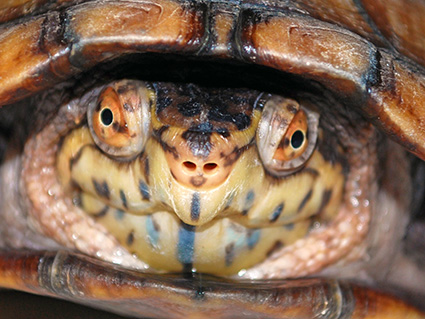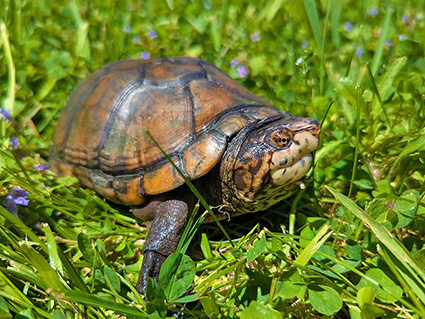Kinosternon scorpioides albogulare | White-throated mud turtle
Name: Ox


Meet Ox
Though small and often shy, Ox the white-throated mud turtle is a master of survival in murky, slow-moving waters. Native to Central and northern South America, this turtle is a subspecies of the scorpion mud turtle, found in countries like Colombia, Costa Rica, Nicaragua, Panama, and beyond.
Ox is one of our Animal Ambassadors and lives behind the scenes, helping us share the importance of wetland conservation and the role turtles play in keeping aquatic ecosystems clean and healthy.
Where Water Meets the Wild
White-throated mud turtles are semi-aquatic reptiles, often found in:
- Freshwater ponds with thick vegetation
- Swamps and slow-moving streams
- Flooded mangrove forests
Unlike some turtles that are strictly aquatic, this species often ventures onto land, especially during the rainy season. During dry periods, they burrow into mud or leaf litter to stay cool and moist—a clever strategy for surviving in unpredictable tropical climates.
A Turtle with Armor (and a Hinge!)
These turtles have a highly domed shell—usually brown or olive—that helps them blend into muddy, leaf-strewn habitats. One of their most unique features is a hinged plastron (the lower part of the shell), which allows them to partially close their shell, offering extra protection from predators.
Unlike fully aquatic turtles, like sea turtles, white-throated mud turtles don’t have strong webbing between their toes. This gives them more mobility on land, hinting at their more terrestrial lifestyle compared to their pond-dwelling cousins.
Opportunistic Omnivores
Ox may not be picky, but he sure is purposeful! White-throated mud turtles are opportunistic omnivores, meaning they'll eat what they can find in their environment. Meat, plants, everything looks good to them!
In the wild, their diet includes:
- Insect larvae, especially dipteran fly larvae.
- Mollusks – an invertebrate that has a soft body and is usually enclosed in a shell, either wholly or partially, like a snail, slugs, or mussels.
- Arthropods – an invertebrate that has a segmented body, jointed legs, and a hard exoskeleton, like spiders, lobsters, and ants.
- Fruits and vegetation.
At the zoo, Ox enjoys a similar variety:
- Mixed greens and produce
- Earthworms and crickets
- Shrimp, clams, cockroaches, and fish
- Mazuri Freshwater Turtle Diet
This balanced, protein-rich diet keeps him healthy and mimics the foraging he’d do in the wild.
Slow and Steady (Really Pays Off)
While their exact lifespan in the wild is still unknown, researchers estimate that white-throated mud turtles can live 40–45 years under the right conditions—possibly longer in human care!
Their slow metabolism, protective shell, and flexible diet all contribute to their long-term survival—so long as their freshwater habitats remain clean and intact.
Fact Sheet
Taxonomy
Genus: Kinosternon | Species: scorpioides | Subspecies: albogulare
Kingdom: Animalia | Phylum: Chordata | Class: Reptilia | Order: Testudiness | Family: Kinosternidae | Subfamily: Kinosterninae |
Favorite Enrichment Type
Anything involving his food, especially his fish or shrimp!
Life Span
- Average life expectancy is unknown but thought to be about 40 to 45 years.
Diet
- In the Wild: Fruits, terrestrial and aquatic invertebrates (molluscs and arthropods), and dipteran larvae, which is common prey.
- At the Zoo: Mazuri® Freshwater Turtle Diet, mixed greens and produce, crickets, cockroaches, shrimp, fish, earthworms, and clams.
Geographic Range
Colombia, San Andrés, Costa Rica, El Salvador, Honduras, Nicaragua, and Panama.
Habitat
Freshwater ponds with vegetation and macrophytes, slow running streams, swamps, floodable mangrove forests that are not permanently connected to the sea.
White-Throated Mud Turtle Fast Facts
- Found in: Colombia, Costa Rica, Nicaragua, Panama, and more
- Habitat: Freshwater ponds, swamps, and floodable mangroves.
- Feature: Hinged plastron to help close their shell for protection.
- Diet: Insects, mollusks, fruit, and aquatic invertebrates.
- Feature: Small and domed, ideal for life in tight, muddy spots.
- Feet not strongly webbed—more adapted to terrestrial movement.
- Burrows during the dry season to regulate temperature and moisture.
Status: Not Evaluated
Conservation: Wetlands in Trouble
Though this species is not currently evaluated by the IUCN Red List, the ecosystems they depend on are increasingly at risk due to:
- Habitat destruction
- Water pollution
- Agricultural runoff
- Human development of wetlands and mangroves
These threats don’t just impact mud turtles—they disrupt entire freshwater ecosystems, affecting everything from insects to birds to humans.
Protecting wetlands is essential for the survival of this species and countless others that depend on these fragile, often overlooked habitats.
Though Ox may live quietly behind the scenes, they play an important role in teaching us how even the smallest creatures are vital parts of their ecosystems. By protecting wetland habitats and reducing pollution, we help turtles like Ox—and the countless other species who call freshwater home—thrive for generations to come.
How to Find Me
Ox is a member of our Ambassador Animals that live behind the scenes! If you would like to meet Ox in person, check out our daily, 11:00am Amphitheater Presentations at the Awareness Amphitheater, located just beyond the covered bridge.
Amphitheater Presentations are dependent on the weather. Please check our activity board, behind the Admissions booth, before coming to see us!
